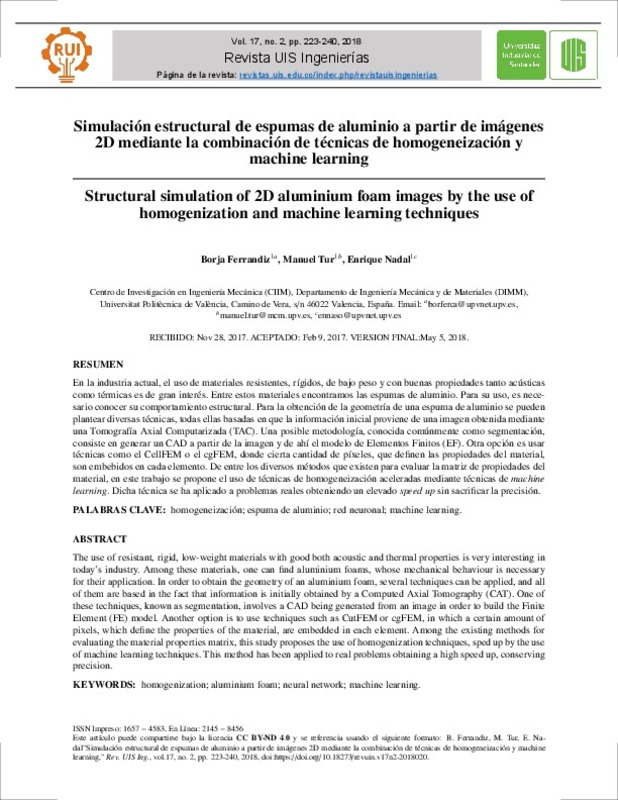JavaScript is disabled for your browser. Some features of this site may not work without it.
Buscar en RiuNet
Listar
Mi cuenta
Estadísticas
Ayuda RiuNet
Admin. UPV
Simulación estructural de espumas de aluminio a partir de imágenes 2D mediante la combinación de técnicas de homogeneización y machine learning
Mostrar el registro sencillo del ítem
Ficheros en el ítem
| dc.contributor.author | Ferrándiz-Catalá, Borja
|
es_ES |
| dc.contributor.author | Tur Valiente, Manuel
|
es_ES |
| dc.contributor.author | Nadal, Enrique
|
es_ES |
| dc.date.accessioned | 2019-07-07T20:01:59Z | |
| dc.date.available | 2019-07-07T20:01:59Z | |
| dc.date.issued | 2018 | es_ES |
| dc.identifier.issn | 1657-4583 | es_ES |
| dc.identifier.uri | http://hdl.handle.net/10251/123279 | |
| dc.description.abstract | [EN] The use of resistant, rigid, low-weight materials with good both acoustic and thermal properties is very interesting intoday¿s industry. Among these materials, one can find aluminium foams, whose mechanical behaviour is necessaryfor their application. In order to obtain the geometry of an aluminium foam, several techniques can be applied, and allof them are based in the fact that information is initially obtained by a Computed Axial Tomography (CAT). One ofthese techniques, known as segmentation, involves a CAD being generated from an image in order to build the FiniteElement (FE) model. Another option is to use techniques such as CutFEM or cgFEM, in which a certain amount ofpixels, which define the properties of the material, are embedded in each element. Among the existing methods forevaluating the material properties matrix, this study proposes the use of homogenization techniques, sped up by the useof machine learning techniques. This method has been applied to real problems obtaining a high speed up, conservingprecision. | es_ES |
| dc.description.abstract | [ES] En la industria actual, el uso de materiales resistentes, rígidos, de bajo peso y con buenas propiedades tanto acústicas como térmicas es de gran interés. Entre estos materiales encontramos las espumas de aluminio. Para su uso, es necesario conocer su comportamiento estructural. Para la obtención de la geometría de una espuma de aluminio se pueden plantear diversas técnicas, todas ellas basadas en que la información inicial proviene de una imagen obtenida mediante una Tomografía Axial Computarizada (TAC). Una posible metodología, conocida comúnmente como segmentación, consiste en generar un CAD a partir de la imagen y de ahí el modelo de Elementos Finitos (EF). Otra opción es usar técnicas como el CellFEM o el cgFEM, donde cierta cantidad de píxeles, que definen las propiedades del material, son embebidos en cada elemento. De entre los diversos métodos que existen para evaluar la matriz de propiedades del material, en este trabajo se propone el uso de técnicas de homogeneización aceleradas mediante técnicas de machine learning. Dicha técnica se ha aplicado a problemas reales obteniendo un elevado speed up sin sacrificar la precisión. | es_ES |
| dc.description.sponsorship | Los autores agradecen la ayuda recibida por el Ministerio de Economía y Competitividad a través del proyecto DPI2013-46317-R así como el apoyo recibido por la Generalitat Valenciana mediante el proyecto Prometeo/2016/007. | es_ES |
| dc.language | Español | es_ES |
| dc.publisher | Universidad Industrial de Santander | es_ES |
| dc.relation.ispartof | Revista UIS Ingenierías | es_ES |
| dc.rights | Reconocimiento - Sin obra derivada (by-nd) | es_ES |
| dc.subject | Homogeneización | es_ES |
| dc.subject | Espuma de aluminio | es_ES |
| dc.subject | Red neuronal | es_ES |
| dc.subject | Machine learning | es_ES |
| dc.subject | Homogenization | es_ES |
| dc.subject | Aluminium foam | es_ES |
| dc.subject | Neural network | es_ES |
| dc.subject.classification | INGENIERIA MECANICA | es_ES |
| dc.title | Simulación estructural de espumas de aluminio a partir de imágenes 2D mediante la combinación de técnicas de homogeneización y machine learning | es_ES |
| dc.title.alternative | Structural simulation of 2D aluminium foam images by the use ofhomogenization and machine learning techniques | es_ES |
| dc.type | Artículo | es_ES |
| dc.identifier.doi | 10.18273/revuin.v17n2-2018020 | es_ES |
| dc.relation.projectID | info:eu-repo/grantAgreement/MINECO//DPI2013-46317-R/ES/PERSONALIZACION DE IMPLANTES MEDIANTE MODELOS DE ELEMENTOS FINITOS A PARTIR DE IMAGENES MEDICAS 3D/ | es_ES |
| dc.relation.projectID | info:eu-repo/grantAgreement/GVA//PROMETEO%2F2016%2F007/ES/Modelado numérico avanzado en ingeniería mecánica/ | es_ES |
| dc.rights.accessRights | Abierto | es_ES |
| dc.contributor.affiliation | Universitat Politècnica de València. Departamento de Ingeniería Mecánica y de Materiales - Departament d'Enginyeria Mecànica i de Materials | es_ES |
| dc.description.bibliographicCitation | Ferrándiz-Catalá, B.; Tur Valiente, M.; Nadal, E. (2018). Simulación estructural de espumas de aluminio a partir de imágenes 2D mediante la combinación de técnicas de homogeneización y machine learning. Revista UIS Ingenierías. 17(2):223-240. https://doi.org/10.18273/revuin.v17n2-2018020 | es_ES |
| dc.description.accrualMethod | S | es_ES |
| dc.relation.publisherversion | https://doi.org/10.18273/revuin.v17n2-2018020 | es_ES |
| dc.description.upvformatpinicio | 223 | es_ES |
| dc.description.upvformatpfin | 240 | es_ES |
| dc.type.version | info:eu-repo/semantics/publishedVersion | es_ES |
| dc.description.volume | 17 | es_ES |
| dc.description.issue | 2 | es_ES |
| dc.relation.pasarela | S\362099 | es_ES |
| dc.contributor.funder | Ministerio de Economía y Competitividad | es_ES |
| dc.contributor.funder | Generalitat Valenciana | es_ES |








